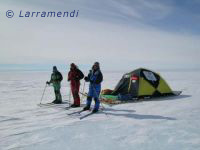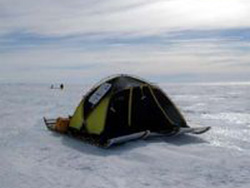The Great Antarctic Crossing
Ramón Larramendi, Juanma Viu et Ignacio Oficialdegui


 13 January
13 January
So, the three Spaniards finally made their way to the edge of the polar plateau where a russian helicopter came to fetch them at 70° S and 80° E.
Three days before getting to that meeting point, they had the fear of their lives when they realised that they had lost uner way much of the technical equiment. Fortunetaly, they kited back and found the luggage...
Larramendi and his two companions have covered 4500 km en 63 days. They are now on board of the russian scientific vessel Akademik Federov at Myrni russian scientific base.
4 January 2006 : mental is low
One can understand that the mental of the three Staniards is quite low in this final part of their expedition after having been obliged to change plans and to kite towards the Russian base Myrni instead of heading to Terra Nova Bay.
Also since these last days, the wind is getting weaker and they are progressing quite slow now : 60 km on January 1st, 102 km the next day and only 34 km on January 3rd !
1 January 2006 : Italians say "NO"
Quite a sensational turn of events for this spanish expedition : being hosted by russians researchers at Vostok scientific base, they received the information according which Italians have denied Larramendi and his two companions the permission to reach the Terra Nova Bay research station.
Actually, Larramendi and his team needed the help of an italian plain to get them out of the polar plateau. At first, they had the permission allright, but when they asked for the official papers, the italian answer turned to a "no".
So they had to change plans and ask to the Russians the help of one of their airplane, which they received without any problem.
No need to say that the disappointment is quite heavy for the three explorers.
22 December 2005
These last days, spanish trio is moving quite fast. Actually faster than one could imagine for a sportive expedition crossing the entire 6th Continent. We remember these guys have broken a record : 311 km in 24 hours of navigation. This was on December 17th. Well, two days later, they could kite for 213 km in a little more than twelve hours of navigation !!! On December 20th, they covered 181 km and on the 22nd, they reached the russian scientific base of Vostok. Where the Russians study the famous Vostok Lake located at a depht of about 3700 m. It covers a surface of about 10 000 km². Coring the ice until just above the lake wher they found ice of 500 000 years old!
18 December 2005
Since they left the Pole of Inaccessibility, morale for the three Spaniards, Larramendi, Viu and Oficialdegui has been sky-high. Sure, they are still encountering difficult surfaces and are coming across sastrugis over 1.5 metres tall - and there have been a number of breakages on the sledge, too. But what is giving them real heart is the fact that they are making good progress.
By 14 December, day 33 of their expedition, they had already covered 1800 km. But the big surprise happened a few days later. It was on 17 December that the terrain suddenly flattened out like a miracle for the first time since they set out, enabling them to keep going round the clock! This is because the way in which their catamaran has been built enables part of the team to rest while the other(s) keep it going.
Result: on 17 December, in 24 hours, they managed to cover the amazing distance of 311 km! This feat beats the record set by our countrymen, Alain Hubert and Dixie Dansercoer during their trans-Antarctic expedition in 1997-98.
13 December 2005
The Spaniards have encountered fewer problems with their catamaran-sledge in recent days. But since they reached an altitude of 3400 metres, the terrain has become flatter and there are fewer sastrugis. Which means they are devouring incredible distances! As was the case on 9 December, when they covered 142 km in nine hours of hard work, having already done 73 km two days previously.
All of which meant that on Sunday 11 December, they reached the famous Pole of Inaccessibility, one of the most remote and inhospitable places on the planet. Only two expeditions have been there before. The first was the Soviets in the 1960s, with the Americans making it there a few years later on its mission to map Antarctica. There was a Belgian researcher from Brussels Open University (ULB) on that expedition by the name of Edgard Picciotto.
Spirits are sky-high and the repairs made to the catamaran appear to be holding… They are currently at an altitude of approximately 3 650 metres.
5 December
Larramendi says that the terrain they have had to negotiate in recent days is the worst of the whole expedition. There are sastrugis over a metre high, resulting in the catamaran-sledge crashing into blocks of snow as hard as concrete. Sometimes it ends up teetering astride one of these waves of ice or else plunges waist-deep into a crevasse! And things continue to break. Straps, ties under the sledge, etc. But they still managed to cover 93 km the day before yesterday and 67 yesterday.
2 December 2005 / 81°25' S / 23°01' E
Another fine distance covered: 87 km on 30 November. 1 December was a rest day under canvas. Temperatures are a little milder: minus 30°C instead of minus 48°C!
30 November 2005 / No position
95 km on 25 November, 108 km on the 26th and 96 km on the 27th... Things appear to be looking up for Larramendi, Viu and Oficialdegui. Not only have they had fewer breakages in recent days, but they are also encountering better conditions, with the sastrugi not so high as before. The three men also came to realise on 25 November that by putting more distance between their sails and the sledge, in other words by lengthening the ropes towing them, they are able to make faster and more comfortable progress. Before their discovery, there was 150 metres of rope to the sails, whereas now they are 300 metres from the catamaran. The result is they are now moving at 15 km/h, compared with 3 km/h before. Which means they are managing to cover an average of 100 km a day, which is what they had planned for in their original figures.
Also on 27 November, which was day 15 of their trip (if our calculations are correct, because they haven't released any details), they passed the 1000 km mark.
 23 November 2005 / 77°41 S / 7°48' E
23 November 2005 / 77°41 S / 7°48' E
The three Spaniards have already covered over 600 km since they set out on 12 November. On the 20th, they had to stop and repair the Teflon parts on the sledge, which were breaking one after the other. On the 23rd, they covered over 100 km and had reached 77°41 S / 7°48' E.
19 November 2005 / 76°04' S / 4° 21' E
Every days brings its crop of minor technical problems, although fortunately it has been possible to repair all of these hitches at this stage of the adventure. But all these fiddly bits of work take up time, as does changing from one size of sail to another - about an hour. They are currently 1 350 km from the pole of inaccessibility. Distance covered on the 18th and 19th: 143 km - including 58 km in just 6 hours on the 19th.
17 November 2005 / 74°54' S / 3°59' E
It looks as though the wind is going to be extreme throughout this expedition, making it both the best friend and worst enemy for the three men. To give you an example: on 15 November, a wind blowing at approximately 50 km/h enabled them to cover 86 km in one day, whereas the next day, the same strength of wind was enough to break one of the cross-struts on the sledge! So, more repairs were needed. Since they have been on the move again, the three men are literally flying over the ice at an average speed of between 20 and 40 km/h. “It's odd,” writes Larramendi on his website, “but once you get 40 metres off the ground, the wind speed increases significantly, from 50 km/h to over 60 km/h, or even more...”
12 november 2005 / 73° 21'11" S / 04°16'35"E
The information from the expedition of the Spanish trio Larramentdi, Viu and Oficialdegui is patchy at best – in fact, the new website has barely been up and running for a week. However, we do know that a few days after they landed at the Russian base of Novo on 10th November, the team was airlifted as far as the plateau , thereby circumventing the difficulties posed by the Sor Rondane mountains and the problem of climbing up to the plateau itself. In any event, it would appear that they finally left on 12th November and that on their very first day were able to cover 86 km in 11 hours with their catamaran sledge and 60 sq.m sail!
The following day, a major binding on their sledge broke, but they were able to make repairs in good time.
Having said that, it's no picnic for the Spaniards, with a temperature of minus 46ºC out on the plateau, not to mention the wind-chill! But, so far so good, and all is well aboard their incredible machine.